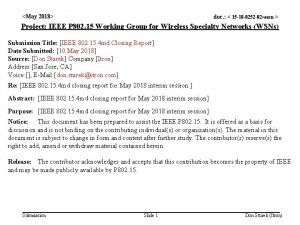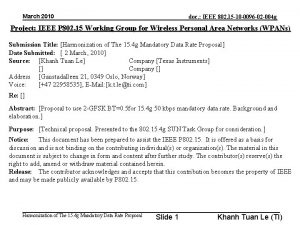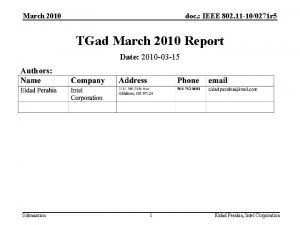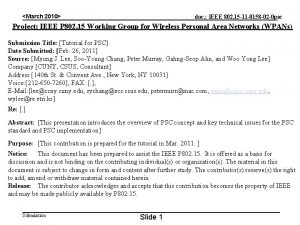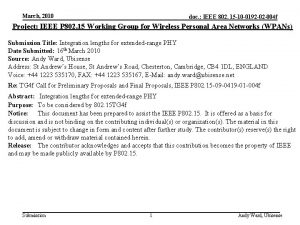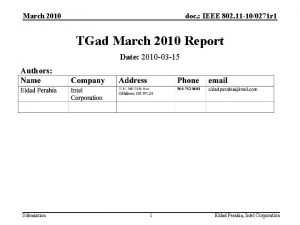March 2010 doc IEEE 802 11 10 0252









![March, 2010 doc. : IEEE 802. 11 -10 -0252 -00 -00 ad References [1] March, 2010 doc. : IEEE 802. 11 -10 -0252 -00 -00 ad References [1]](https://slidetodoc.com/presentation_image_h2/9708ff99bda42ae83b782226c9fcc175/image-10.jpg)

- Slides: 11

March, 2010 doc. : IEEE 802. 11 -10 -0252 -00 -00 ad Simultaneous Beam Training Date: March 2010 Authors: Name Affiliations Address Phone Email M. Hossein Taghavi Qualcomm San Diego 858 651 -6373 mtaghavi@qualcomm. com Avinash Jain Qualcomm San Diego 858 651 -5964 avinashj@qualcomm. com Hemanth Sampath Qualcomm San Diego 858 658 -1848 hsampath@qualcomm. com Submission Slide 1

March, 2010 doc. : IEEE 802. 11 -10 -0252 -00 -00 ad Background • Beamforming is necessary to achieve multi-Gbps throughput in 60 GHz band. – Necessary to overcome severe path loss & directionality in 60 GHz. • For a robust 60 GHz network: – STAs needs to beam-train periodically to account for blockage, movement, change of orientation, etc. – STAs need to use dedicated service (time) periods to beam-train, to prevent traffic disruption to other 60 GHz devices. • The beam training overhead can be significant for 60 GHz network with multiple STAs. Submission Slide 2

March, 2010 doc. : IEEE 802. 11 -10 -0252 -00 -00 ad Example Beam-Training Overhead Calculation • Consider a conference Room scenario with 4 pairs of STAs communicating: – Assume beam training uses 15. 3 c long preamble (4. 7μs) Training Overhead (% of Total Channel) Total # of Tx/Rx Beams or Directions 5 Beam Training Periodicity (ms) 10 20 40 60 16 15. 04 7. 52 3. 76 1. 88 1. 25 32 30. 08 15. 04 7. 52 3. 76 2. 50 64 60. 16 30. 08 15. 04 7. 52 5. 01 128 120. 3 60. 16 30. 08 15. 04 10. 02 256 240. 6 120. 3 60. 16 30. 08 20. 05 • Beam training by 4 pairs of STAs using separate dedicated times can lead to significant overhead. – This significantly reduces perceived network throughput Submission Slide 3

March, 2010 doc. : IEEE 802. 11 -10 -0252 -00 -00 ad Solution: Simultaneous Beam Training • Allow multiple pairs of STAs to perform beam training simultaneously • Each pair of STAs uses a different training sequence in order to mitigate interference – The different training sequences may be based on different Golay codes – It is easy to generate multiple Golay codes using the same hardware with good crosscorrelation properties • Example: Two complementary Golay sequences of length 128 with good correlation properties • Simultaneous training of even 2 pairs of devices can reduce the beam training overhead by 50% Submission Slide 4

March, 2010 doc. : IEEE 802. 11 -10 -0252 -00 -00 ad Conference Room Simulation Setup • We will demonstrate performance of simultaneous Tx beam training of 2 pairs & 3 pairs of STAs – Channels generated using the TGad Conference Room channel model, and as defined in the TGad evaluation methodology – Transmitter parameters: • Training sequence is transmitted across each of Tx beams in a random order • 19 Tx beams total of 60 o HPBW, covering the half-space z>0 – Receiver parameters: • Training sequence is received in an omni-directional mode (covering z>0) and using a simple correlator detector • Receiver selects the best Tx beam by comparing the strength of the received training sequences across all beam directions. • A random delay of 0 -20 chips has been added to model in-room propagation delays. – Performance results are averaged over 100 channel realizations, and 10 noise realizations and beam-ordering per channel realization. Submission Slide 5

March, 2010 doc. : IEEE 802. 11 -10 -0252 -00 -00 ad Case #1: Simultaneous Training of 2 Pairs of STAs • • • Assume STA 2 STA 1 training uses Golay code a 128 from 802. 15. 3 c Assume STA 7 STA 8 training uses Golay code b 128 from 802. 15. 3 c To illustrate benefit of interference suppression using distinct Golay codes, performance is compared to the case where every STA uses a 128 as the training sequence Training of 2 pairs STAs using the same training sequence STAs using different training sequences STA 2→STA 1 STA 7→STA 8 PBest PFailure 6. 8% 100% 88. % 0. 0% PBest = Probability of correctly selecting the best beam PFailure = Probability of selecting a wrong beam that is at least 3 d. B worse compared to the best beam. Ø 50% reduction of training overhead with no performance degradation Submission Slide 6

March, 2010 doc. : IEEE 802. 11 -10 -0252 -00 -00 ad Case #2: Simultaneous Training of 3 Pairs of STAs • • Assume STA 2 STA 1 and STA 7 STA 8 trainings use Golay codes a 128 and b 128 respectively, from 802. 15. 3 c. The third pair STA 6 STA 3 training uses concatenation of Golay codes a 64 and b 64 from 802. 15. 3 c Training of 3 pairs STAs using the same training sequence STAs using different training sequences STA 2→STA 1 STA 7→STA 8 STA 6→STA 3 PBest PFailure 10. 3% 100% 5. 9% 100% 98. 6% 84. 2% 0. 0% 87. 9% 0. 0% 0. 3% PBest = Probability of correctly selecting the best beam PFailure= Probability of selecting a wrong beam that is at least 3 d. B worse compared to the best beam. Note: Failure events can be readily flagged as they correspond to low measured SINR of the selected beam. Ø 67% reduction of training overhead with minimal performance degradation. Submission Slide 7

March, 2010 doc. : IEEE 802. 11 -10 -0252 -00 -00 ad Enabling Simultaneous Beam Training in TGad • The Simultaneous Beam training concept can be overlayed on any beam training protocol: – Standard specifies a few Golay based training-sequences with good crosscorrelation properties. – AP allocates the same service (time) period to more than one pair of STAs for beam training. – AP allocates distinct training sequences to these pairs of STAs • Alternately, STAs pseudo-randomly pick a distinct training sequence (e. g: based on STA-ID). • STAs can re-use existing HW to generate and detect these additional Golay based training-sequences. – Each STA needs to generate or detect only one Golay based training sequence, at any given time. Submission Slide 8

March, 2010 doc. : IEEE 802. 11 -10 -0252 -00 -00 ad Conclusion • Enabling simultaneous beam training of multiple pairs of STAs using different Golay-based training sequences can significantly reduce network overhead – Presented examples from the Conference Room Scenario where 3 pairs of STAs can simultaneously perform beam training, resulting in 67% training overhead reduction. – The additional Golay-based training sequences can be generated and detected without change to existing hardware • We are open to comments/suggestions to incorporate this concept in TGad. Submission Slide 9
![March 2010 doc IEEE 802 11 10 0252 00 00 ad References 1 March, 2010 doc. : IEEE 802. 11 -10 -0252 -00 -00 ad References [1]](https://slidetodoc.com/presentation_image_h2/9708ff99bda42ae83b782226c9fcc175/image-10.jpg)
March, 2010 doc. : IEEE 802. 11 -10 -0252 -00 -00 ad References [1] A. Maltsev et al. , “Channel Models for 60 GHz WLAN Systems, ” 802. 11 -09/0334 r 6, 01 -20 -2010. [2] E. Perahia, “TGad Evaluation Methodology, ” 802. 1109/0296 r 16, 01 -20 -2010. Submission Slide 10

March, 2010 doc. : IEEE 802. 11 -10 -0252 -00 -00 ad Straw Poll • Do you support inclusion of the technique, - Simultaneous Beam Training as described in 10/0252 r 0 in the TGad draft amendment? – Y: – N: – A: Submission Slide 11













